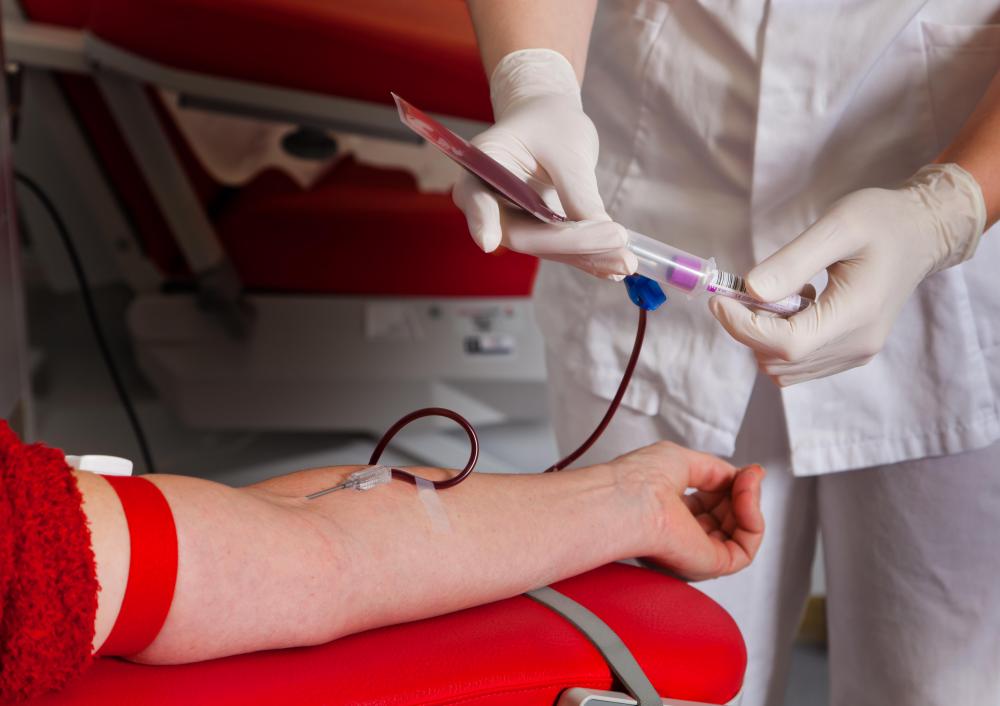At WiseGEEK, we're committed to delivering accurate, trustworthy information. Our expert-authored content is rigorously fact-checked and sourced from credible authorities. Discover how we uphold the highest standards in providing you with reliable knowledge.
What are the Methods of Tuberculosis Transmission?
Tuberculosis transmission happens in a way that is very similar to many common colds. The most frequent method of transmission is when a person coughs and another person breathes in particles that were expelled from the lungs of the person coughing. Exposure to airborne bacteria from an infected person doesn’t necessarily guarantee tuberculosis transmission, and many people can easily fight off tuberculosis without ever getting sick. For those that do become ill, it is common for the disease to lie dormant for a lengthy period. The chances of tuberculosis transmission increase in people with immune system disorders such as autoimmune deficiency syndrome (AIDS).
In the 1800s and earlier, tuberculosis was a very dangerous disease. It killed many people around the world during those days, partly because there was generally no reliable way to treat the disease and people didn’t fully understand the way it was transmitted. Tuberculosis transmission was more common during those times, not because the disease was more contagious, but because there were generally more people walking around with severe infections, and they passed it on to others with their coughing.

Tuberculosis can progress in several different ways, but the most common method is for it to hibernate in a person’s body. After a lengthy period, which can sometimes be years, the tuberculosis symptoms will appear. These can include constant coughing, wasting away, coughing blood, and unexplained sweating. For some people, the symptoms may appear within a few weeks of transmission, but this is relatively rare.

Once a person has been diagnosed with tuberculosis, there is a relatively reliable treatment option available. The treatment can be fairly complex because there are often several drugs involved and they have to be taken at very specific times during each day. If patients make any mistakes in the timing of medications or miss doses, it can potentially throw the whole treatment plan off track temporarily. Another thing that makes the treatment difficult is that it often requires several months of following the strict medication plan to ensure that the disease goes away.

If people wait too long after the appearance of symptoms to seek treatment, tuberculosis can become much more dangerous. When it is left untreated, tuberculosis is still a potentially fatal illness. Among populations in poverty, tuberculosis is still often deadly, and it can also be very difficult for doctors to treat individuals with other health problems, like AIDS, for example, that might be impairing their immune systems.
AS FEATURED ON:
AS FEATURED ON:
















Discussion Comments
@Iluviaporos - Even though they have a cure for TB, it's not really a pleasant cure. I had a friend who managed to pick up an infection after living overseas for a while and they wouldn't let her go on the "good" medication while she was over there, because they are trying to stop the TB bug from adapting to it.
They offered her the not-so-good medication which has to be taken for nine months. And while you are on it, you can't drink at all, in case you damage your liver. You can't eat chocolate either, or fish, or any number of other things.
So, she opted to wait and have the good medication when she got back to the States. In that case, she still had to stop eating those things, but it was only for a month.
The worst part about this story is, if they had those restrictions on one traveler, I imagine that means no one in affected (and poorer) countries is allowed to have the "good" medicine.
@bythewell - I was volunteering in Africa for a while and they told us never to drink milk without boiling it first. Boiling milk can get rid of the TB, so pasturized milk that you buy in the store is always going to be safe, and you don't have to worry about it.
But that is one of the reasons that there are rules about drinking unpasturized milk. It would be all too easy for TB to become a problem in Western countries again, because it is so prevalent in populations of wild animals, like deer and so forth.
And it takes such a long time to kill that it can spread quite effectively over time.
Tuberculosis can also be transmitted through milk. This is one of the reasons it is so very difficult to get rid of TB in the world, even though they have medications that can cure it.
I know in my part of the world, it can infect possums, which are considered quite a pest to farmers.
The possums can then infect cows, and as it says in the article, often the infection is difficult to detect unless you test regularly for it.
If the infection then gets into the milk it is much easier for people to catch it than if they were to get it from another person. And, because no one expects to have TB in the modern world, the symptoms of tuberculosis can often be attributed to something else.
It's actually becoming more of a problem than people realize.
Post your comments